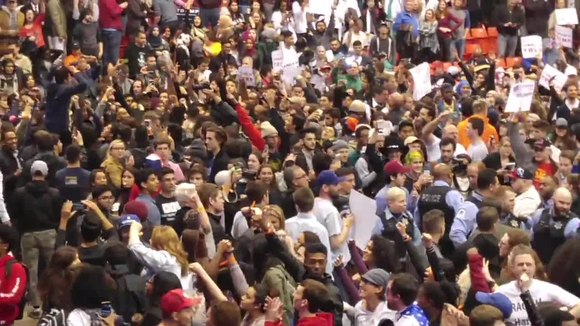
A GIF generated from a 16mm film transfer depicting Chicago Police and protesters outside the 1968 Democratic National Convention. Note the sign in the background that reads ‘Make Love Not War.’ GIF from the US National Archives, prepared by Victor Grigas, public domain.
Wikipedia articles about historic events can sometimes host amazing photography and video. Sometimes, they don’t.
The Wikipedia articles for United States political conventions, such as the 2016 Republican National Convention and the 2016 Democratic National Convention, at which the parties are (and will be) officially nominating their presidential candidates, typically contain ‘stock’ images of the event location and possibly one or two photos of relevant people, and that’s about it.
It can take a bit of dedication by Wikipedia editors to illustrate articles on news events well. A lot of the effort goes into finding good illustrations through research.
My interests in editing Wikipedia as a volunteer revolve around Chicago, my home city. I can find no shortage of articles to start, expand or find (better) illustrations for. It’s fun. You just have to find a topic you love. I’ve written about bars like the Old Town Ale house (that Wikipedian and film critic Roger Ebert called “the best bar in the world that I know about”) or the nightclub ‘Neo’ which seems to be the nightclub that inspired the name of Keanu Reeves’ character in ‘The Matrix’.
It’s also fun to find old newspaper articles about restaurants like Ceres Cafe or the Wieners Circle, or places like Maxwell Street (that’s the street you see in the film The Blues Brothers where Aretha Franklin sings). Sometimes it’s a a big blizzard or sometimes it’s people like Peter Schivarelli—who still manages the band Chicago after umpteen decades—or characters like 43rd Ward alderman Paddy Bauler, who once shot a police officer for calling him “a fat Dutch pig.” Sometimes it’s more serious topics like Kids off the Block or the Shooting of Laquan McDonald.
When Donald Trump announced his candidacy for President of the United States, I read about a Latino-owned brewery which immediately canceled a contract to provide beer to a bar in Trump Tower Chicago and renamed the beer to something I probably shouldn’t quote in this blog post. With local reactions like that, I knew that if/when Trump campaigned in Chicago there would probably be a large protests, possibly worthy of a Wikipedia article. I don’t live in Chicago right now, so when the day of the Trump rally/protest came, I was looking for any freely-licensed footage that might be available to migrate to Wikimedia Commons to better illustrate Wikipedia articles (if I had been there in the city, I’d be out with my camera). I looked on Flickr and found this:
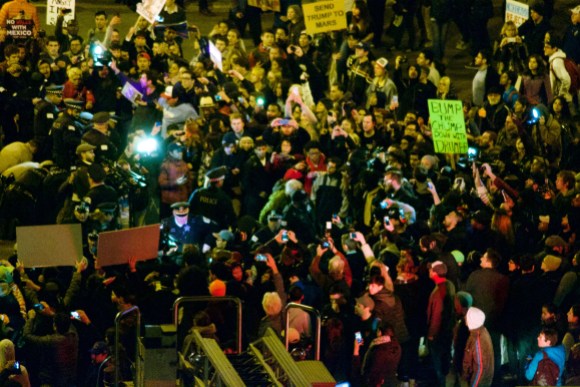
I migrated some videos from Voice of America, which are sometimes in the public domain. Archive.org didn’t have anything, but I did find some videos on YouTube, and used a Firefox plugin to download the videos, and another tool to convert them to .webm to upload to Wikimedia Commons.
The above gives you an idea of what you might be able to find as a Wikipedian when there is a new event — people with digital tools sharing digital media and flipping a switch to release the image to share collectively. Sometimes it’s easy to get, but sometimes it isn’t.
What about an older protest? If it happened before 1923, any of that media is public domain. I’ve illustrated articles about the 1886 Haymarket affair by showing up at the Chicago Police headquarters with a big camera asking to take photos of the 100+ year-old statue outside (they obliged and then hurriedly escorted me off the property). I’ve also bought postcards stamped 1906 on eBay that show the original statue. Snapshots of old newspapers also work.
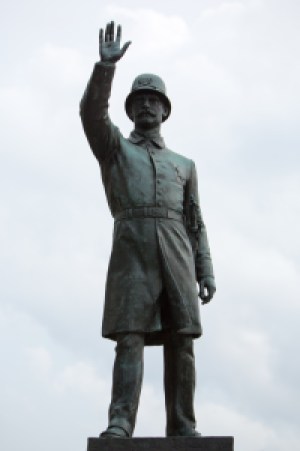
What if an event is after 1923, but before the digital era?
Wikimedia Commons (the media archive that Wikipedia uses) has a gap for imagery in this era. Commons only accepts media that is freely licensed, but many of the images from the mid-to-late twentieth century are still copyrighted in the United States (where the Wikimedia Foundation servers are). Many twentieth century images are held in for-profit archives with an incentive to collect, maintain, and preserve it, but little incentive to allow you or me access without us paying for it. Remixing these images is even harder to do, legally speaking.
Look at the article for the 1968 Democratic National Convention protest, right in the middle of the twentieth century. In 1968 my father owned a handsome Victorian apartment building at 1920 Clark Street that was literally across the street from Lincoln Park, the place where Abbie Hoffman and the Yippies set up an alternative place from the convention center to protest the convention and the Vietnam War. I grew up hearing about the mess the hippies made in the park, a Rolls-Royce car that my father saw that had been turned upside down after a protest, and a German-American neighbor who stood outside her house holding a shotgun so that “They won’t get my house”.
The 1968 convention was a very well filmed and photographed event, famous for the crowd chanting “The whole world is watching, the whole world is watching” live on television to “the whole world”—and yet this Wikipedia article contained no images. Not a single image to illustrate (what I think) is one of the most important moments of the 20th century in US history. Imagine reading about the Berlin Wall without seeing any photos of it. Personally, I think that it’s not enough to read about something; I want to see it too. I thought that there must be something out there to illustrate this; someone’s grandma has a shoebox of Polaroids or something they can give me to put in this Wikipedia article.
First, I looked at Wikimedia Commons. Maybe there was a big batch upload from some library that had a few snapshots that hadn’t been tagged appropriately yet? Nope. Then I looked on Flickr. Tons of photos of the protest, but only one free photo. I migrated that one. I looked on YouTube and Vimeo for images of the ’68 protest. I found nothing marked as Creative Commons that looked legitimate.
I looked on eBay. Eureka! I found some color slides. They illustrated the protesters, the Chicago police, the National Guard and the Hilton Hotel. I had to ensure it was legal for me to use them, they were too new to be public domain. I asked the seller where they came from, and I was told they came from an estate sale. Remembering the film ‘Finding Vivian Maier‘, where a guy (in Chicago) finds a huge archive of slides and negatives from a then-unknown deceased photographer, I knew that when original media like slide film or negatives are sold to a new owner, the copyrights of that media also transfer to the new owner. So for about $5 each I bought 5 slides, scanned them, labeled them appropriately, and uploaded them to Commons to use in the Wikipedia article.
I was happy.
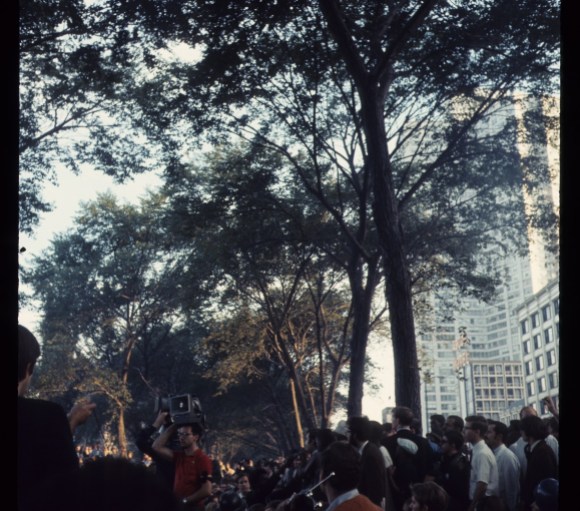
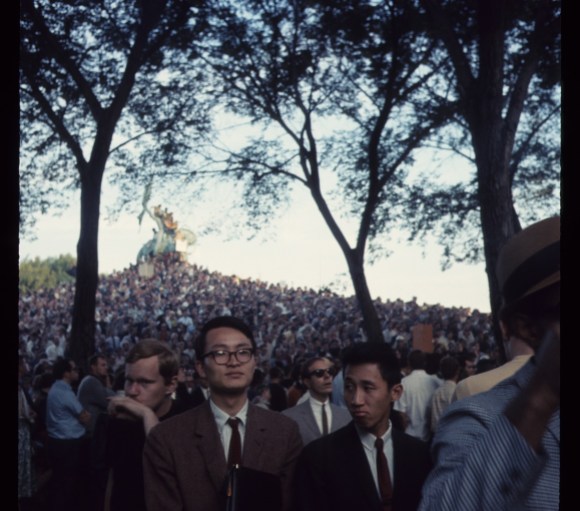 These scanned slides, bought off of Ebay, show a speaker with a megaphone (top) addressing a crowd of protesters (bottom) in Grant Park under a statue of John A. Logan. Photos one, two by Bea A Corson, scanned by Victor Grigas, public domain.
These scanned slides, bought off of Ebay, show a speaker with a megaphone (top) addressing a crowd of protesters (bottom) in Grant Park under a statue of John A. Logan. Photos one, two by Bea A Corson, scanned by Victor Grigas, public domain.
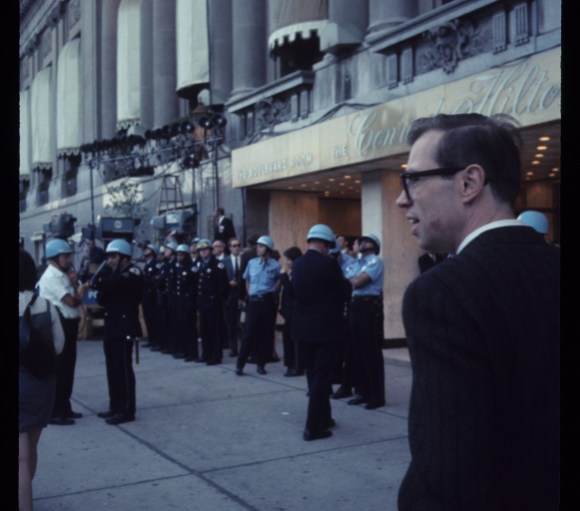
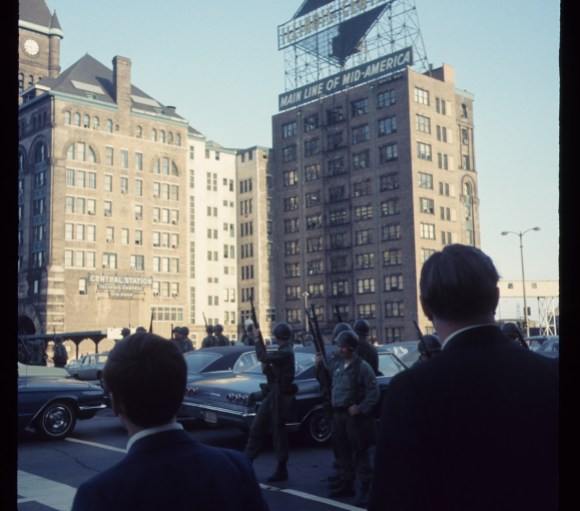 Chicago Police outside the Conrad Hilton (top) National Guard troops in downtown Chicago (bottom). Photos one, two by Bea A Corson, scanned by Victor Grigas, public domain.
Chicago Police outside the Conrad Hilton (top) National Guard troops in downtown Chicago (bottom). Photos one, two by Bea A Corson, scanned by Victor Grigas, public domain.
I also found some interesting silent film footage on Google. I could see the rock band MC5 playing in Lincoln Park, a ‘FREE STORE’ sign above a pile of clothes, and shots of the Chicago police dragging protesters away on Michigan Avenue. It had DASPO CONUS on a dummy slate throughout the film, indicating a possible production company. I looked for ‘daspo conus’ and found it was a branch of the United States Department of the Army from 1962 to 1974—meaning that the original footage is in the public domain and I can use it because it was made by a member of the United States government during the course of their official duties.
The footage on this for-profit site, however, was watermarked, which makes it a derivative work and now copyrighted, so I couldn’t just migrate it—I had to find an original copy. I looked at the US National Archives website for ‘DASPO’ and ‘1968 Chicago’ and found 2 links that appeared to indicate betacam transfers of an original 16mm film on file.
I then emailed some people at Wikimedia DC in case they might know anyone who could help find this footage and migrate it for me. I forgot about it after that. It was a shot in the dark.
Then I got an email from a librarian at the US National Archives, who said that she had the footage. She sent it to me via Google Drive, I converted it to .webm, uploaded it to Wikimedia Commons, and embeded the video into appropriate Wikipedia articles.
A standard definition transfer of a betacam transfer of a 16mm film of the 1968 Democratic National Convention and protests. Video by DASPO, scanned by the US National Archives, public domain/CC0.
I made another request—I asked the librarian if it might be possible for her to re-scan the original film. The file she sent me is illustrative, but it seems to be a bit grainy, and it’s not just because it’s old. I’m about to get a bit technical here, so bear with me: in the 1960s most motion images were shot on actual film. The motion image that I got from NARA, according to the file-keeping records about it, seems to have been a standard definition betacam (video) transfer of the original 16mm film, and the digital file I received was a transfer of that. I got a transfer of a transfer—a copy of a copy. That ‘grainyness’ can be avoided if you can do a new digital transfer of the film. Just make one copy, and do it well.
The librarian told me that it might be a few weeks for the request to go through. I told her okay, that I was just looking to get the 1968 Democratic National Convention article to be better illustrated with free media. When she replied to me, it turned out she found two more films shot (and edited by another branch of the US government) from inside the convention that I didn’t even know about. I uploaded and linked everything appropriately.
A 1080p transfer of the original 16mm film of the 1968 Democratic National Convention. Video by DASPO, scanned by the US National Archives, public domain/CC0.
Another film of the Democratic convention that shows events inside the convention itself. Reel 2 is also available on Commons. Video by DASPO, scanned by the US National Archives, public domain/CC0.
And that’s how I illustrated the 1968 Democratic National Convention protests.
So what do you need to do if you have an event like a speech or a protest to cover? First, go shoot footage yourself. There’s an app for that. Use the Commons app to easily upload photos to Wikimedia Commons. If you shoot a video, YouTube or Vimeo allow you to mark your works as Creative Commons and then anyone can migrate the video to Wikipedia.
You can also check to see if there is any media on popular sites already, like Wikimedia Commons, YouTube.com, Vimeo.com, Flickr.com and Archive.org. Just search photos for ‘cc-by’, ‘public domain’ or ‘commercial use with modifications’ in Google. You could also go to your local library or check on Etsy.com or eBay.com, like I did.
If all that fails, contact anyone who might have access to original copywritten photos or video. Sometimes if you can get in touch with an original photographer, they are willing to share some images.
And if your grandma has Polaroids in a shoebox that might illustrate something, ask her first before you scan them.
Victor Grigas, Video Producer, Wikipedian
Editor’s note: While Victor is an employee of the Wikimedia Foundation, this is written in his volunteer capacity.

Can you help us translate this article?
In order for this article to reach as many people as possible we would like your help. Can you translate this article to get the message out?
Start translation
